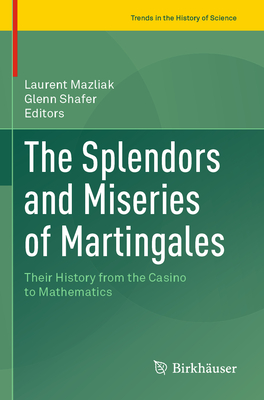The Splendors and Miseries of Martingales: Their History from the Casino to Mathematics

The Splendors and Miseries of Martingales: Their History from the Casino to Mathematics
Over the past eighty years, martingales have become central in the mathematics of randomness. They appear in the general theory of stochastic processes, in the algorithmic theory of randomness, and in some branches of mathematical statistics. Yet little has been written about the history of this evolution. This book explores some of the territory that the history of the concept of martingales has transformed.
The historian of martingales faces an immense task. We can find traces of martingale thinking at the very beginning of probability theory, because this theory was related to gambling, and the evolution of a gambler's holdings as a result of following a particular strategy can always be understood as a martingale. More recently, in the second half of the twentieth century, martingales became important in the theory of stochastic processes at the very same time that stochastic processes were becoming increasingly important in probability, statistics and more generally in various applied situations.
Moreover, a history of martingales, like a history of any other branch of mathematics, must go far beyond an account of mathematical ideas and techniques. It must explore the context in which the evolution of ideas took place: the broader intellectual milieux of the actors, the networks that already existed or were created by the research, even the social and political conditions that favored or hampered the circulation and adoption of certain ideas.
This books presents a stroll through this history, in part a guided tour, in part a random walk. First, historical studies on the period from 1920 to 1950 are presented, when martingales emerged as a distinct mathematical concept. Then insights on the period from 1950 into the 1980s are offered, when the concept showed its value in stochastic processes, mathematical statistics, algorithmic randomness and various applications.PRP: 1022.91 Lei
Acesta este Pretul Recomandat de Producator. Pretul de vanzare al produsului este afisat mai jos.
920.62Lei
920.62Lei
1022.91 LeiLivrare in 2-4 saptamani
Descrierea produsului
Over the past eighty years, martingales have become central in the mathematics of randomness. They appear in the general theory of stochastic processes, in the algorithmic theory of randomness, and in some branches of mathematical statistics. Yet little has been written about the history of this evolution. This book explores some of the territory that the history of the concept of martingales has transformed.
The historian of martingales faces an immense task. We can find traces of martingale thinking at the very beginning of probability theory, because this theory was related to gambling, and the evolution of a gambler's holdings as a result of following a particular strategy can always be understood as a martingale. More recently, in the second half of the twentieth century, martingales became important in the theory of stochastic processes at the very same time that stochastic processes were becoming increasingly important in probability, statistics and more generally in various applied situations.
Moreover, a history of martingales, like a history of any other branch of mathematics, must go far beyond an account of mathematical ideas and techniques. It must explore the context in which the evolution of ideas took place: the broader intellectual milieux of the actors, the networks that already existed or were created by the research, even the social and political conditions that favored or hampered the circulation and adoption of certain ideas.
This books presents a stroll through this history, in part a guided tour, in part a random walk. First, historical studies on the period from 1920 to 1950 are presented, when martingales emerged as a distinct mathematical concept. Then insights on the period from 1950 into the 1980s are offered, when the concept showed its value in stochastic processes, mathematical statistics, algorithmic randomness and various applications.Detaliile produsului








